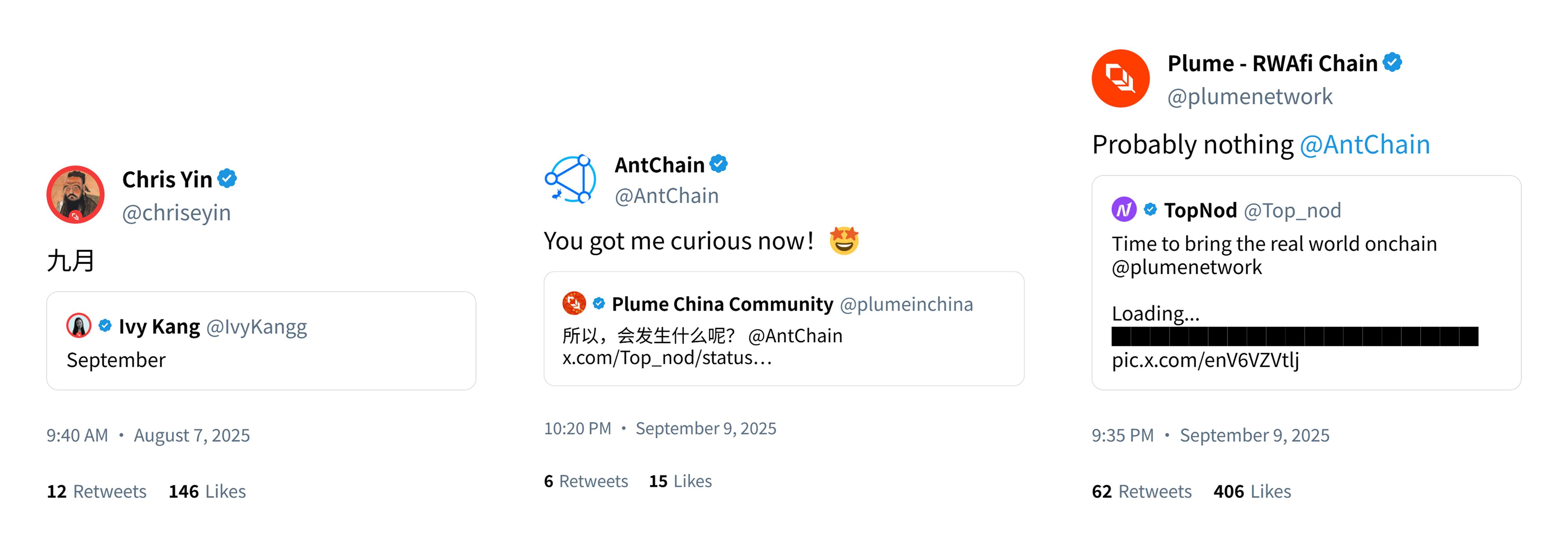The challenges of RWA have never been about "writing the contract," but rather about "bringing the system online."
Written by: Sanqing
In early August, the Plume team sparked speculation with the "September" teaser, and CEO Chris Yin communicated in Chinese, leading the community to anticipate potential collaboration progress in September. Recently, Plume's public interactions with AntChain have further amplified these expectations.

The "Background" and Strengths of the Two Chains
AntChain
Positioning: A leading permissioned consortium chain in China, serving government, enterprise, and industrial internet scenarios.
Technical Features:
Permission and Identity System: Institutional-level CA, enterprise/individual real-name mapping, fine-grained permission control.
Auditable Compliance: On-chain traceability, multi-party consensus among nodes, integration with offline audit/risk control systems.
High Performance and Deterministic Finality: Stable demands for business system reconciliation, settlement, and judicial evidence.
Privacy and Data Governance: Mature capabilities in Multi-Party Computation (MPC), Trusted Execution Environment (TEE), etc.
Proficient Applications: Supply chain finance, cross-border trade compliance, electronic certificates/evidence, industrial collaboration, etc. — "Digitizing real assets and incorporating them into the institutional framework."
Plume
Positioning: An EVM-compatible chain aimed at RWA, focusing on the composability of RWA ✖ DeFi and the developer ecosystem.
Technical Features:
EVM/Account System: Deep compatibility with the Ethereum ecosystem, low migration costs for contracts/tools.
Compliance Modules: Chain-level AML, supporting whitelists, transfer restrictions, secondary verification, and other modular compliance logic.
Native DeFi Friendly: Lego-style combinations of AMM/lending/LP/yield distribution, adaptable to various market-making and derivative strategies.
Open Visibility: Assets are more easily noticed and gain secondary liquidity within the global developer and market-making network.
Proficient Applications: Market making, LP, stable vaults, leverage/loop, yield tokenization, etc. — "Bringing compliant assets to life."
Real Constraints of Interaction Between Permissioned and Public Chains
While the interaction between permissioned chains (like AntChain) and public chains (like Plume) holds great potential, it faces multiple real-world challenges stemming from regulatory, technical, and operational barriers, especially highlighted in the 2025 RWA ecosystem:
Legal Anchor: Onshore asset issuance and investor registries are strictly regulated by local authorities (e.g., requirements from the financial regulatory bodies in mainland China or Hong Kong), making it impossible to simply "move chains" to a public chain environment to avoid compliance risks.
Suitability and Transfer Restrictions: Only qualified investors (e.g., institutions or certified individuals) can hold/trade, and the registry must be in real-time alignment with the original registration system, limiting retail participation and increasing KYC thresholds.
Trust Model of Bridges: Permissioned chains often lack the light client verification typical of public chains, relying on operators, custodians, and regular audits as core security mechanisms, making them susceptible to centralization risks.
Cash Flow and Redemption: The payment of yields, rents, and other returns, as well as redemption at maturity, must achieve cross-border compliance flow while ensuring full traceability and auditability across the chain, posing high technical integration challenges.
Simple technical bridging is insufficient to solve the problem; it must also meet compliance and regulatory requirements, integrate multi-chain interoperability, bridge the advantages of both chains, and minimize risks to lay the foundation for subsequent collaboration models.
However, on August 26, news emerged that Guotai Junan International (GTJAI) collaborated with Ant Group to complete the first batch of structured product tokens' "AntChain - Ethereum" cross-chain issuance, including fixed-income redeemable tokens and principal-protected products linked to US stock ETFs, achieving T+0 settlement and transparent auditing, reflecting a compliance flow mechanism similar to a custodial bridge. This provides a successful case study for cross-chain RWA assets from AntChain to Plume. Additionally, Plume has previously successfully taken on a US dollar money market fund issued by CMB International, recognized between Singapore and Hong Kong.
Speculating Three Feasible Collaboration Models
Model A: One-Way "Issuance Gateway"
Process
Assets are issued/custodied/KYC verified on AntChain;
The gateway institution locks the assets and mints mirror tokens (ERC-20/1155+ compliance hooks) on Plume;
Mirror tokens can only be transferred between whitelisted wallets;
Upon redemption, Plume destroys the mirror tokens, and the gateway unlocks the original asset rights on AntChain.
Characteristics:
Simple, clear, and easy to audit;
Suitable for standardized, short-duration, cash flow-stable assets (e.g., rents, receivables/factoring).
Risks: Limited liquidity, reliance on gateway trust.
Model B: Two-Way "Custodial Bridge"
Building on Model A, add:
Proof of Reserves (PoR): Regular disclosure of on-chain/off-chain reconciliations;
Multi-signature/Custodian System: Diversified operational risks;
Layered Shares: Priority/subordinated structures to match different risk appetites.
This can enhance market trust and support a richer array of yield and term management products. Risks: Collusion among custodians may amplify systemic issues.
Model C: ZK-KYC and Programmatic Compliance
Investors complete qualification verification on the AntChain side and receive an anonymous qualification certificate (ZK proof);
When trading on Plume, only prove "I meet the conditions" without exposing identity details;
Achieving both compliance and privacy, suitable for a more open secondary market and market-making network.
Conclusion
The challenges of RWA have never been about "writing the contract," but rather about "bringing the system online." AntChain provides the anchor of systems and credit, while Plume offers the engine of markets and combinations. If we take "trusted gateway + mirror tokens" as the framework, supplemented by PoR, custody, and auditing, AntChain's RWA can maintain compliance while embracing liquidity. However, actual collaboration requires regulatory review and carries technical and geopolitical risks. It is advisable to continue monitoring official updates; only when "stability" and "vitality" truly coexist will this bridge reach its most valuable moment.
免责声明:本文章仅代表作者个人观点,不代表本平台的立场和观点。本文章仅供信息分享,不构成对任何人的任何投资建议。用户与作者之间的任何争议,与本平台无关。如网页中刊载的文章或图片涉及侵权,请提供相关的权利证明和身份证明发送邮件到support@aicoin.com,本平台相关工作人员将会进行核查。




